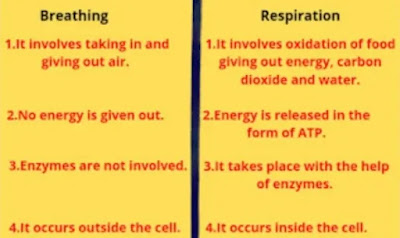Respiration is carried out by the respiratory system in humans which is one of the eight organ systems of the body. It mainly consists of nose, trachea and lungs. Some other organ systems include circulatory system, digestive system, skeletal system etc. It is an important topic for ICSC biology class 6 .This chapter for Respiratory system in humans has two parts. To check the part 2 of this chapter click on this link : https://lessonstobelearneda-z.blogspot.com/2022/04/breathing.html
Respiration Definition
The process in which food is oxidized in the body to get CO2, energy and H2O is known as respiration. So we need oxygen for the process of respiration that is obtained by the process of breathing.
Which are the stages of respiration?
There are two stages of respiration -
1.Breathing - It is also known as external respiration. It involves taking inside oxygen and giving out carbon dioxide. The exchange of these gases i.e oxygen and carbon dioxide takes place with the help of lungs.
2. Cellular Respiration - It is also known as internal respiration. When food is combined with oxygen to get energy, carbon dioxide and water, this type of process is known as cellular respiration.
Food + O2 ➡ CO2 + H2O + energy
The energy which is released in the process of cellular respiration is stored in the body in the form of ATP. The full form of ATP is Adenosine Triphosphate. Later on these ATP molecules are broken down to get energy which is used in various metabolic processes.
Which is the difference between breathing and respiration?
 |
| Difference between breathing and respiration |
Which are the different types of respiration?
Respiration is of two types. These are -
1.Aerobic Respiration - This type of respiration takes place in the presence of oxygen. It is found in human beings and higher animals. Food is oxidized completely to get water and carbon dioxide. 38 molecules of ATP are produced from one molecule of glucose.
C6H12O6 + 6O2 ➡ 6CO2 + 6H2O + 38ATP
2.Anaerobic Respiration - In this type of respiration, food gets oxidized in the absence of oxygen. It is found in lower organisms such as yeast, bacteria etc. Food is not oxidized completely. Only 2 molecules of ATP are produced from one molecule of glucose. Carbon dioxide and ethyl alcohol are also produced in this process.Anaerobic respiration occurs in our body inside the muscles during vigorous exercise.
Absence of
C6H12O6 ➡ C2H5OH + 6H2O + 2ATP
oxygen
Which are the main parts of the respiratory system?
Lungs are the main respiratory organs that help in the exchange of gases. Respiratory tract is the passage through which air passes to the lungs and then moves back outside to the atmosphere is known as respiratory tract. It consists of nostrils or nose, pharynx, larynx,wind pipe or trachea, bronchi that is divided into bronchioles, alveolar sacs and alveoli.
.webp) |
| Structure of Lungs in Human Beings |
1.Nasal Cavity - It is the upper region of the respiratory system that consists of hairs and mucus. Air enters the body through this nasal cavity. The hair present in the nasal cavity act as filter. Dust particles and germs are trapped by this hair and mucus . The purified air is then passed to the lungs.
2.Pharynx - It is the path through which both air and food can pass.
3.Larynx - It is also known as the voice box as it helps in the production of sound.
4.Trachea - It is also known as the wind pipe . It helps in passing the air to and from the lungs.
5.Bronchi (singular -bronchus) - These are two tube like structures that emerge out from the trachea.
6.Bronchioles - These are the branches that emerge out of from the bronchi.
7.Alveolar Sacs - These are the sacs that are found at the end of the bronchioles. These consist of tiny structures known as alveoli. Million of alveoli are present in each lung that increase the surface area for the absorption of oxygen through capillaries.
 |
8.Lungs - Human body consists of two lungs. The left lung has two lobes while the right lung has three lobes. The lungs are surrounded by a double layer of membrane from outside known as the pleural membrane. There is a fluid present in between these two layers known as the pleural fluid.
Note : If you want to follow the chapter only then just follow the link given for part 2 of this chapter. No need to follow the external links given in between the chapter.
Hope you liked this article for the topic Respiration for ICSC biology class 6 . Please share it and comment if you want article on any other topic. You can practice this topic using Worksheets for Science related to this topic.
Related Topics
Digestion of Food + Worksheets
Fertilization in Plants + Worksheets
Matter|Matter Properties + Worksheets
Air and the atmosphere + Worksheets
ICSC|Class 6|Chemistry|Water + Worksheets
How many muscles are in a human's body? + Worksheets
ECG - How to read? + Worksheets
What is blood pressure lower number? + Worksheets
Parts and Functions of the Nervous System + Worksheets
Functions of a Nervous System + Worksheets
Spinal Cord in Humans - Spinal Cord Structure and Spinal Cord Injury + Worksheets
Spinal Cord Injury + Worksheets
The Human Skull Bones + Worksheets
Infection in Kidneys + Worksheets
Kidneys Transplantation Cost + Worksheets
The Human Brain Anatomy + Worksheets
The Human Digestive System + Worksheets
Structure of the Teeth + Worksheets
Which vitamins are soluble in water? + Worksheets
Healthy Diet Plan + Worksheets






0 Comments